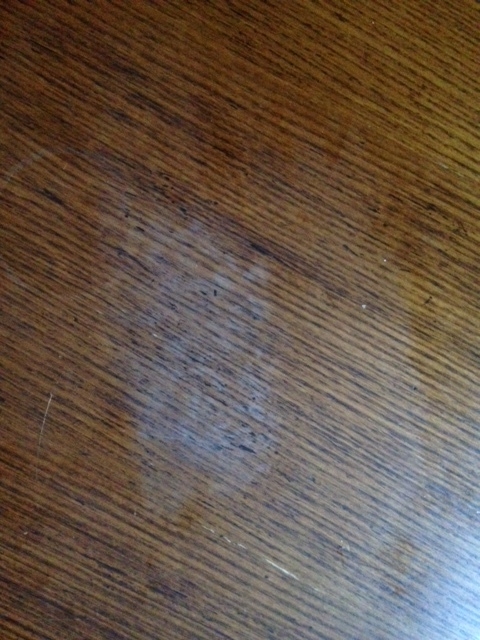Whew, What a Save! Removing Stains from Wood Furniture
Months ago, a white stain appeared on my kitchen table. No one remembers leaving a perspiring glass or bowl on the table. Regardless when I glanced to the left from my chair that white shaped blob bugged me. With guests expected, I would try to strategically arrange my husband’s placemat over the stain, but that not only looked awkward, it was slightly out of range of his eating area.
Fast forward a few weeks when my mom inquired about removing an ink stain from her Formica kitchen table which then set me to work on solving my own exasperating problem. I was now determined to banish that ugly water stain. When it first manifested, I tried several home remedies. Baking powder (which actually removed some of the finish…still working on that), vinegar, and toothpaste with no luck.
My web search led me to try just one more option, ironing. I selected the lowest setting and placed a cloth napkin on the table and began ironing. In total, it took nearly 10 minutes so don’t expect immediate results. However, keep checking as you go to adjust the temperature, location, and to watch progress. Important caveat: use cotton not polyester fabrics to iron. The latter gave off too much moisture while the cotton wicked it up. And, you can knock out some ironing at the same time.
As you can see from the after shot, the stain is virtually gone (it had been where the pen point is). On the area where the finish had been rubbed off previously, I smeared a touch of mayonnaise. That helped a little, but not enough. After wiping that off, I applied some coconut oil. And voila. See the photo.
Yay, no more awkwardly placed placemats and no more embarrassing stain!
Word of caution, please use a low setting if you try this and do so at your own risk!
Paint Recycling
Its the "fixer-upper" time of year. Lots of folks are busy working on their landscaping; cleaning out garages; pressure washing sidewalks, driveways, and porches; lacquering outdoor furniture; and painting.
A fresh coat of paint can make drab rooms or a tired exteriors appear bold, clean, and inviting. If you are selling your home, your realtor may have suggested livening up a room or two or toning down others to enhance marketability.
Once you embark on a painting project, what do you do with the leftover paints, primers, lacquers, and waterproofing sealers?
You could:
save leftovers for a future project or touch-ups
donate unused paint (ScrapPDX-be sure to check scrappdx.org/donate/items-we-accept for guidelines)
recycle used paint
The PaintCare recycling program offers latex and oil-based drop-off sites throughout Oregon for five gallon cans or smaller regardless of age. They will ensure that the paint is converted into fuel, other products, or properly disposed.
You have already paid the recycling disposal fee at the time of purchase, so it makes economic and environmental sense to take advantage of this program if you have a location nearby. To find your nearest location: click here for Paint Care's search tool or call 855-724-6809. Locate sites outside Oregon on the link. Products accepted for collection are included on the featured flyer and also available at Paintcare.orgIf you have other waste disposal or recycling questions, be sure to contact Metro at oregonmetro.gov.





